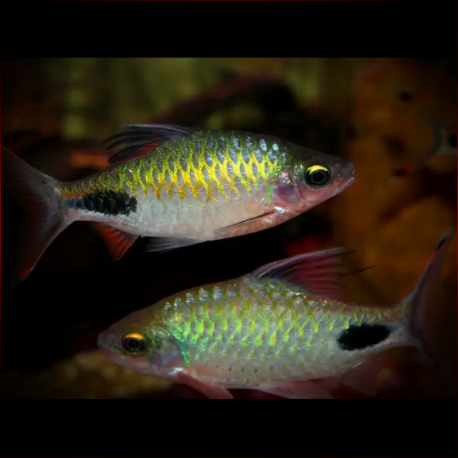More info
Datasheet
| Minimum Tank Size | 240 litres / 63.40 US gallons |
| Maximum Size | 9.5cm / 3.74inches |
| Temperature | 19°C / 66.20°F - 25°C / 77.00°F |
| Hardness | 2.02dgH / 36ppm - 10.03dgH / 179ppm |
| pH | 6.0-7.5 |
General Description
Dawkinsia rohani, formerly classified under the genus Puntius, is a small fish species typically reaching 9.5cm in size. It is recognized by its striking coloration, which includes a black club-shaped blotch extending from the lateral line to the caudal-fin base.
Aquarium Setup
When setting up an aquarium for D. rohani, it is recommended to mimic a flowing stream environment. Utilize a substrate of rocks, sand, and fine gravel. Include driftwood and hardy aquatic plants like Microsorum and Anubias. Water quality should be pristine, with regular water changes and moderate water movement.
Behaviour
This species thrives in a peaceful community setup with other riverine species. D. rohani is a schooling fish by nature, so maintaining a group of 8-10 individuals is ideal. In a well-populated tank, aggressive behavior is usually contained as they focus on establishing a hierarchy within the group.
Feeding and Diet
Being an omnivorous forager, D. rohani eats various foods like worms, insects, plant material, and organic debris in the wild. In captivity, they should be fed a varied diet consisting of live and frozen foods such as bloodworms, Daphnia, along with quality dried flakes and granules for optimal health.
Reproduction & Dimorphism
Reproduction practices for D. rohani involve egg-scattering free spawning. Conditioned adults are introduced to a separate breeding tank with suitable conditions for egg laying. Males develop more intense coloration and tubercules during spawning, while females tend to grow larger and exhibit a less vibrant color pattern.
Habitat and Distribution
This species is native to the Kanyakumari District in Tamil Nadu, India, inhabiting riverine environments with specific preferences for hill streams over lowland areas. D. rohani has been found in river systems like Paralayar and Pamburivaikal.
Please note that no conclusions have been made regarding the species, as further research may provide additional insights.

